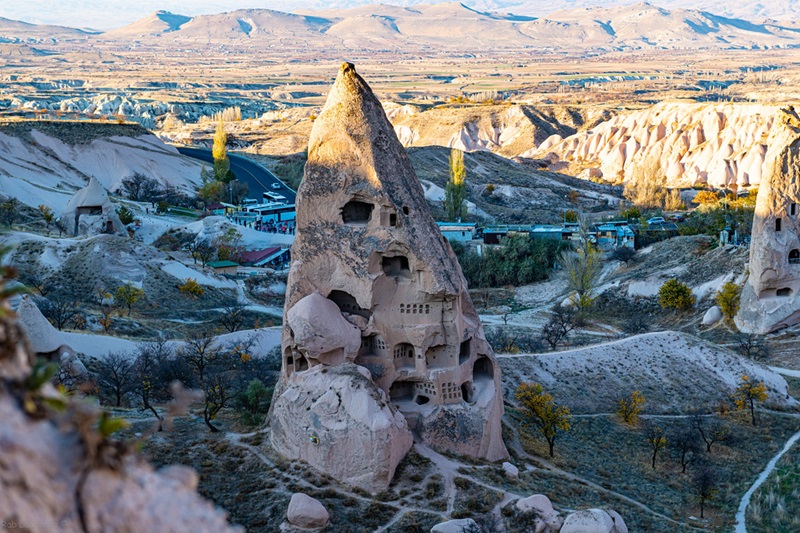
It was in February 2016 that archaeologists unearthed a unique rock-carved Byzantine-era underground church in Nevsehir, Cappadocia, central Turkey.
The 1,500-year-old church was decorated with never-before-seen frescoes depicting Jesus rising into the sky, what the Bible calls the Ascension. There are also ones showing Jesus destroying evil in the Final Judgement. Other frescoes depict the apostles, saints and prophets.
Stunning Byzantine Frescoes in an Underground Church beneath a Fortress
ca. 500 AD https://t.co/2zM41wXzlb Nevşehir #Turkey #archaeology pic.twitter.com/iNiakwXDWH— Ticia Verveer (@ticiaverveer) December 8, 2016
The discovery of the church is a significant find, as it provides new insights into the early Christian history of Cappadocia. It is also a reminder of the rich cultural heritage of the region.
The church in Nevşehir has not been officially named yet. It is currently being referred to as the “Nevşehir Underground Church” or the “Church of the Ascension” due to the prominent fresco depicting Jesus’ ascension into heaven. The archaeologists who discovered the church are still working to piece together its history and identify its exact origins.
Historic church discovered in Turkey’s Nevşehir ‘could change history of Orthodoxy’ https://t.co/yn1zS9q8Pv pic.twitter.com/mfmNriThs2
— Roman Middle East (@RomanMiddleEast) February 5, 2016
Frescoes in the Byzantine Church had never been seen before
The discovery was made during the raising of an urban housing project in the city of Nevşehir.
“We know that such frescoes have so far never been seen in any other church,” said Hasan Ünver, mayor of Nevşehir. “It was built underground and has original frescoes that have survived to this day. This place is even bigger than the other historical churches in Cappadocia.”
“It is reported that some of the frescoes here are unique. There are exciting depictions like fish falling from the hand of Jesus Christ, him rising into the sky, and the bad souls being killed. When the church is completely revealed, Cappadocia could become an even bigger pilgrimage center of Orthodoxy,” Ünver said.
Christian pilgrims and tourists have long visited Cappadocia for its famed cone-shaped rock clusters that served as hermitages for early monks. The newly unearthed church is proof that the region’s geography shelters still more hidden treasures of faith.
Cappadocia has a long and complex history, dating back to the Hittite Empire in the second millennium BC. However, it was in the first century AD that Christianity began to take root in the region.
According to tradition, the apostle Peter preached in Cappadocia, and the apostle Paul may have also visited the region. In the early centuries of the Christian era, Cappadocia became an important center of monasticism, with many hermits and monks seeking solitude in the region’s rugged landscape.
The most famous churches in Cappadocia
The Goreme Open Air Museum: This UNESCO World Heritage Site contains several churches, chapels, and monasteries, dating from the 10th to the 12th centuries. The frescoes in these churches depict scenes from the Bible and the lives of the saints and are notable for their vivid colors and intricate details.
The Dark Church: This church, located in Goreme, is famous for its dark interior, which has helped to preserve its stunning frescoes. The frescoes in the Dark Church depict scenes from the New Testament, such as the Nativity and the Crucifixion, as well as scenes from the lives of the saints.
One of the most impressive locations you can visit at Cappadocia is the 11th century #Dark #Church where incredible frescoes depicting the life of Jesus Christ from birth to death are preserved for all to enjoy. #Turkey #Nevsehir #Goreme #OpenAirMuseum #UNESCO pic.twitter.com/wduFdMNdat
— Turkish Museums (@TurkishMuseums) November 11, 2020
The Church of St. John the Baptist: This church, located in the village of Cavusin, is notable for its unique architecture, which includes a rock-cut bell tower. The frescoes in the church depict scenes from the life of John the Baptist, as well as images of the Virgin Mary and Christ.
Related: Greeks of Cappadocia Left Indelible Mark on History
